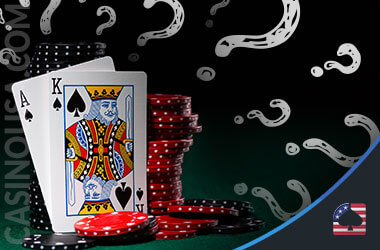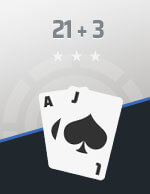
Most people think that blackjack is one of the simplest table games in a casino. The dealer deals cards, and the goal is for your sum of cards to be close to or exactly 21.
The math is easy — if the dealer goes over 21, but you don’t, you’ve won. It’s as simple as that.
However, there are many other complexities to this game, especially in live blackjack games, that you need to know about. Learning all the actions you can take and the bets and side bets you can make will benefit your playing style.
With a deeper understanding of the game, you’re bound to become a much better blackjack player than before. Moreover, the more of an expert you are, the more you’ll win because blackjack is the only casino game besides poker that requires both skills and luck to win.
So, with that in mind, let’s take a closer look at all the actions, bets, and side bets you can place in a typical game of live blackjack.
Basic Options and Bets in Live Blackjack
Betting in blackjack is something you always do before the dealer starts dealing. In essence, there is not much to it — you take a few chips and place them on the virtual table. In most cases, you’ll be able to bet between $2 and $500 per hand, depending on the rules of the online casino.
Then, as the round moves on, you can choose to:
Stand
![]() After the dealer deals you two cards, you can choose to stand and not get any additional cards.
After the dealer deals you two cards, you can choose to stand and not get any additional cards.
It’s ideal to do this if the sum of your cards is 17, 18, 19, 20, or, of course, 21 — the natural blackjack.
You can also choose to stand after receiving more than two cards.
Hit
![]() This option gets you an additional card. You should always use it if the sum of your initial two cards equals 16 or less.
This option gets you an additional card. You should always use it if the sum of your initial two cards equals 16 or less.
Naturally, you need to think about whether you want to choose this option because you can always get a high card that will get your sum above 21.
However, if the sum is 10 or less, you should definitely continue as you are highly unlikely to win with such a small number.
Split
![]() When your first two cards form a pair of identical values, you can choose to split the cards into two columns and receive an additional card to complete each hand.
When your first two cards form a pair of identical values, you can choose to split the cards into two columns and receive an additional card to complete each hand.
What’s more, your initial bet is also divided into two halves. You should:
- Always split if you get two aces or two eights;
- Never split if you receive two tens, two fours, or two fives.
Double Down
![]() This option lets you double your initial bet if the sum of the two initial cards is 9, 10, or 11.
This option lets you double your initial bet if the sum of the two initial cards is 9, 10, or 11.
However, remember that you have to do it as soon as you get your first two cards. Plus, you’ll have to stand after you get an additional card.
You should do this only in three specific cases:
- If you get a hard 9 (the cards you get are two and seven, three and six, or four and five), and the dealer’s face-up card is two, three, four, five, or six.
- If you get a hard 10 or hard 11 (the cards you get are two and eight, three and seven, four and six, five and five or two and nine, three and eight, four and seven, five and six) and the dealer gets a card lower than yours.
- If you get 16, 17, or 18 in total while the dealer’s face-up card is two, three, four, five, or six.
Surrender
![]() With this option, you get half your initial bet back.
With this option, you get half your initial bet back.
You should only use it if you truly believe that you have no chance of winning that round.
Side Bets in Live Blackjack

Side bets in blackjack are additional bets you can place apart from your initial bet. Players get to choose from a whole plethora of side bets. Which one you’ll get to make depends on the live blackjack game varient you’re playing.
Side bets can yield large winnings, so it’s worth learning about the most common types you’ll likely encounter.
However, before you begin, you should know that side bets are a fun thing to try out, rather than something that has a reasonable probability of occurring.
Most of them rarely happen, so you can’t count on them to help you win; that’s what strategies are for. Plus, you should use side bets only if you have funds to spare.
21+3
 This side bet follows three-card poker hands, so you can get paid depending on what your initial two cards and the initial dealer’s face-up card are. In other words, these three cards need to form a specific poker hand for you to win a significant amount.
This side bet follows three-card poker hands, so you can get paid depending on what your initial two cards and the initial dealer’s face-up card are. In other words, these three cards need to form a specific poker hand for you to win a significant amount.
Here are the usual hands you can bet on and the typical payouts for each:
- Flush (three cards with the same suit) — 5:1
- Straight (a run of consecutive cards) — 10:1
- Three-of-a-kind (three same cards) — 30:1
- Straight Flush (successive cards with the same suit) — 40:1
- Suited three-of-a-kind (three cards with the same suit and number) — 100:1
Perfect Pairs
![]() Perfect Pairs is the second most popular side bet in live blackjack. It allows you to wager on your initial two cards being a pair.
Perfect Pairs is the second most popular side bet in live blackjack. It allows you to wager on your initial two cards being a pair.
You can bet on that pair being:
- The same color (Colored Pair) — the payout is typically 12:1
- The same suit and number (Perfect Pair) — the payout is usually 25:1
- The same number or card value but different color and suit (Mixed Pair) — the payout is normally 6:1
Insurance
![]() This side bet lets you “add insurance” to your initial bet if the dealer lands a blackjack. You can place this bet if the dealer’s face-up card is an ace. Keep in mind that you will only get 2:1 on the insurance bet if the dealer lands a blackjack while forfeiting the initial stake.
This side bet lets you “add insurance” to your initial bet if the dealer lands a blackjack. You can place this bet if the dealer’s face-up card is an ace. Keep in mind that you will only get 2:1 on the insurance bet if the dealer lands a blackjack while forfeiting the initial stake.
For example, if you bet $10 and place an insurance bet of $5, you get $15 in total only if the dealer lands blackjack, but you’ll forfeit the initial stake. In other words, you end up even if you lose the original bet, but the dealer gets blackjack.
Due to this, insurance is rarely a worthwhile bet, as the dealer’s chances of getting a blackjack won’t get much higher if they have an ace. Plus, you only earn money if the dealer hits a blackjack.
Bet Behind
![]() This is an option you get in some live blackjack games, and it allows you to bet on any other seat in the game. However, you can’t decide what that player does and how they play — you can only bet on them.
This is an option you get in some live blackjack games, and it allows you to bet on any other seat in the game. However, you can’t decide what that player does and how they play — you can only bet on them.
These bets are rarely helpful, but they could be a good thing if you notice an outstanding player who seems to be getting most of their hands right.

